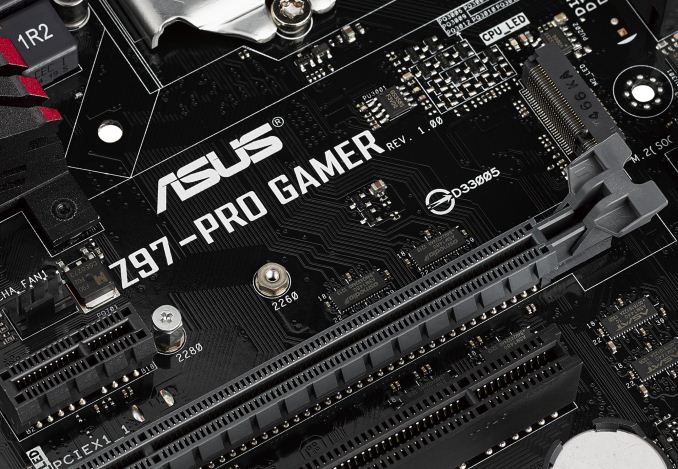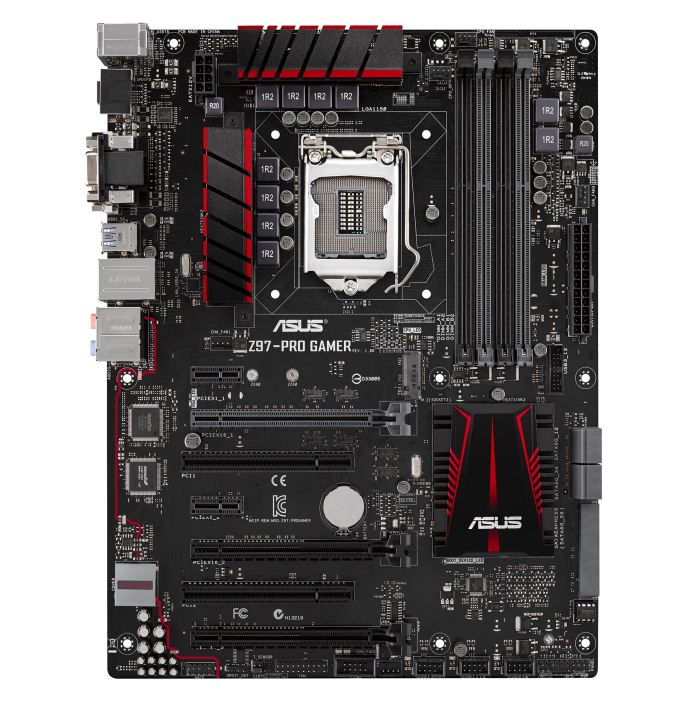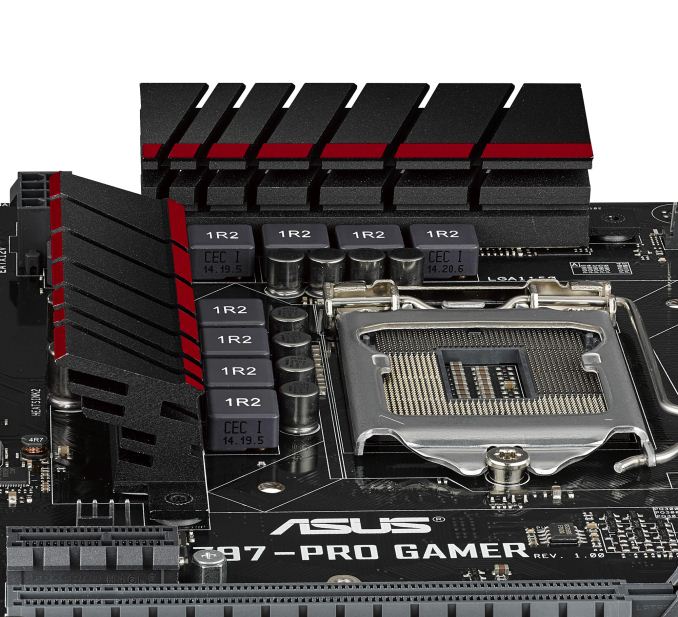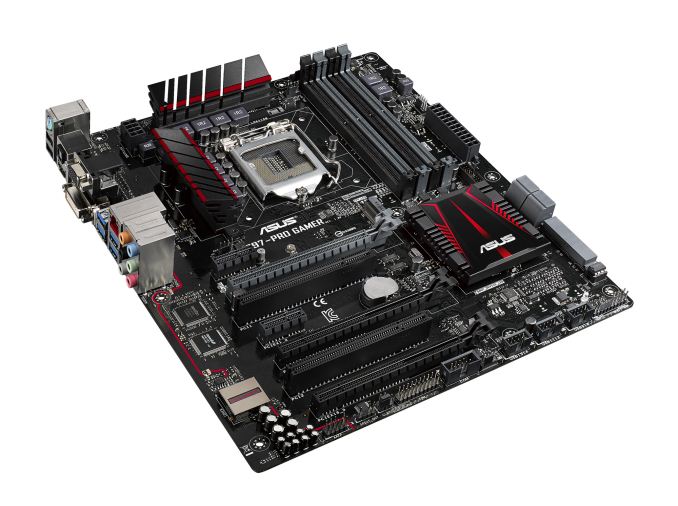ASUS Announces Z97 Pro Gamer: Semi-ROG for Pentium-AE Gaming
by Ian Cutress on October 31, 2014 7:08 AM EST- Posted in
- Motherboards
- Intel
- Asus
- ROG
- Z97
- Pentium-AE

The flagship ASUS gaming motherboards are designed to offer the best ASUS’ R&D have to offer and are often the lynchpin in a number of enthusiast builds. These feature a number of components and software elements that the channel motherboard range does not have, such as GameFirst, SupremeFX or Sonic Radar. ASUS has brought some of these features down their ROG product line to the Maximus VII Gene, Hero and Ranger for more budget oriented builds, however when it comes to pairing a $70 CPU like the overclockable Pentium G3258 with an ROG board, the ROG board might still be 2-2.5x the cost. As a result, ASUS is today announcing a semi-ROG board combining elements from the channel range and the ROG range in order to offer something more cost effective for budget users interested in a bit of overclocking and gaming. This is the Z97-Pro Gamer.
The Z97-Pro Gamer is almost a cut down version of the Z97-Pro, but with ROG gaming features added. From the channel side of the equation we have M.2 x2 and SATA Express support along with ASMedia controllers for extra USB 3.0 ports and PCIe to PCI connectors. From ROG it borrows some of the aesthetic qualities (red/black heatsinks), SupremeFX audio, ROG oriented DIGI+ control of the power delivery, extended BIOS options and the ROG software package.
The PCIe layout focuses on an x8/x8 split for SLI and Crossfire, with a final PCIe 2.0 x4 from the chipset for additional cards rather than an x8/x4/x4 split overall for tri-AMD gaming which might not scale appropriately with a Pentium CPU. The USB and Ethernet ports are protected individually against electrostatic discharge, with that Ethernet port being an Intel (I218-V I would assume) to be used alongside the GameFirst II packet prioritization software. The SupremeFX audio hides an ALC1150 codec with PCB separation, EM shields and auto-detecting headphone amplifiers.
As this announcement was made via the ROG website, the North American official announcement might not be far away. At the point in time where the board is officially released, we should learn more about pricing and availability.
Source: ROG



















17 Comments
View All Comments
danjw - Friday, October 31, 2014 - link
Asus, a little hint, no one uses PCI slots anymore. So save a little money and drop the connectors and traces. Other than that, it sounds like a nice board for budget gamers.nathanddrews - Friday, October 31, 2014 - link
My Audigy4Pro does. I still use it for older EAX-enabled games that don't otherwise support surround sound over HDMI.dgingeri - Friday, October 31, 2014 - link
I still have a PCI audio card, a HT Omega Striker 7.1. I haven't been able to use it in quite a while because my boards haven't had PCI slots, but I still have it, and it still has updated drivers.DanNeely - Friday, October 31, 2014 - link
The bigger money savings (still only a dollar or so) would probably be in not having the PCIe-PCI bridge chip needed to add legacy PCI in the first place. The problem is that Intel's chipsets don't offer enough PCIe lanes for full ATX boards. The 16 on the CPU generally go to 2 slots; leaving 5 positions for the chipset to fill. It has 8 lanes; but a few of those get eaten by onboard devices: Audio, network, possibly a real USB3 controller (instead of a hub), possibly a firewire controller (although these are mostly history), possibly PCIe based storage (m.2 or sata express), or possibly thunderbolt.As a result if the mobo vendor wants to offer an x4 slot off the chipset (or even just use a large number of extra onboard devices) they need to either leave a few slots locations on the board empty or use a bridge chip of some sort. The PCIe-PCI bridge is cheaper than a PLX to multiply 2 lanes into 4 or 4 into 8; so especially on budget boards it tends to be what's picked.
Skylake is rumored to be bumping the CPU from 16 to 20 lanes to better support PCIe storage. While that change will help keep the lane shortage from getting worse on gaming systems, they really do need to offer a chipset variant with 12 lanes instead of 8 if they want OEMs to stop using PLXes/bridge chips just to fill out higher end boards. (And if they want to boost thunderbolt adoption, they need to put TB into the chipset as well).
Fortunately it appears that they are bumping PCIe and USB3 significantly on the higher end 100 series chipsets. The Z170 is being rumored to offer 20 PCIe lanes, 10 USB3 ports, and support for up to 3 x4 m.2 SDDs. However it's not quite as good as it initially sounds, to get those numbers they've heavily pumped up output multiplexing: The 36 PCIe/USB3/Sata3 lanes/ports are only backed by 26 outputs from the chipset; meaning there're 10 shared outs up from 4 on the current generation: 4 USB3/PCIe3, and 6 PCIe/Sata. It's still a big jump from the 18 configurable IO ports on the 80/90 series chipsets though.
http://www.extremetech.com/computing/186210-intels...
DanNeely - Friday, October 31, 2014 - link
Something I didn't notice before; the ExtremeTech article has the CPU staying at 16 lanes and all the growth on the chipset which I suppose makes sense with sataexpress needing PCIe and Sata connections. They've bumped the DMI bandwidth up with a new version as well; but since all the articles I can find use different units for DMI 2 (20gbit/sec) and DMI3 (8 giga-transfers/sec). None of them have stated the width of DMI3; or commented on encoding details but if we assume it continued to track PCIe standards, DMI3 will have double bandwidth/lane. However, unless Intel also doubled the width of it as well the risk of bottlenecking is significantly higher since the southbridge is now offering ~4x as much IO capacity. That might not be a real world concern since maxing out traffic every IO port at once is a really contrived scenario; OTOH I don't know how close DMI2 is to being saturated in real world scenarios.StrangerGuy - Friday, October 31, 2014 - link
At 4-core side of things, I would rather *very* much give Intel the an extra $100 for a stock clocked 4.2GHz 4790K instead of saving that $100 with a 4690K and then use the money on cooling and a "better" mobo. 4-core OCing is so overrated since Devil's Canyon.Neil131 - Sunday, March 1, 2015 - link
Did Asus realeased this already in the US? I live in Taiwan and I got his board for about US$160.00 Paired it with an i5-4690k. If your looking for a mobo for the Pentium-AE, MSI Z97 pc mate is the best out there, at about $90... more or less...